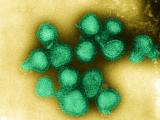Nov 10, 2011 (CIDRAP News) – The United Kingdom today released an update of its flu pandemic plan, which for the first time addresses three varying levels of impact.
The revision updates the region's 2007 plan, and many of the changes revolve around lessons learned during the 2009 H1N1 pandemic and the latest scientific evidence, the Department of Health said in a press release.
The 2009 H1N1 pandemic was a mild-to-moderate event in many countries, which posed some response difficulties in ones that had planned for a severe scenario. Also, in some countries, health officials faced political pressure over resources spent on vaccination and arrangements with pharmaceutical companies.
The new UK plan, detailed in a 70-page document, addresses three possible scenarios: low impact, moderate impact, and high impact. Each defines what is needed for the pandemic to reach that level, describes key healthcare delivery actions, considers the impact on the wider community, and includes guidance on public messaging.
Goals of the new plan are to offer more flexibility and clearer communication between all parts of the government response, the health department said, adding that the plan was developed in consultation with a range of health and human services professionals.
Health Secretary Andrew Lansley said in the statement: "Good communications, strong preparations, and close working with our health and social care professionals are key to ensuring the impact on services and to the public is kept to a minimum should a pandemic occur."
Other key changes address the need to have better plans for the initial response that focus on the rapid and accurate assessment of the new flu virus, a proportionate response based on the demands of the virus, and the need to take into account age-specific and other differences in the rate and spread of disease, according to the document.
The plan addresses measures such as serology to measure the severity of the pandemic in its early stages, information from behavioral scientists on the public's response, and better plans for managing the end of a pandemic.
Though the World Health Organization (WHO) pandemic phases are useful at the global level to describe the spread of the virus and guide country decisions, they aren't applicable as a planning tool in individual countries, the report says. The new UK plan no longer uses the WHO phases as triggers for its own actions.
Alongside today's new plan, the UK pandemic planners used a set of scientific papers that guides the use of pharmaceutical and behavioral interventions. The plan also calls for a Scientific Advisory Group for Emergencies (SAGE) to advise the government's actions and ensure that they are based on scientific evidence.
The new plan gives physicians more flexibility to prescribe antivirals for patients who are not in risk groups but does not adopt a general household prophylaxis strategy.
Vaccine production is highly complex and a vaccine wouldn't be available for 4 to 6 months after the start of the pandemic, so the government is in discussions with manufacturers about securing new advance supply agreements, the plan states. It added that the vaccine isn't likely to have an impact during the first wave of infections but could be a useful during subsequent waves, especially in vulnerable populations.
See also:
Nov 10 UK pandemic preparedness strategy
Nov 10 Department of Health press release


















